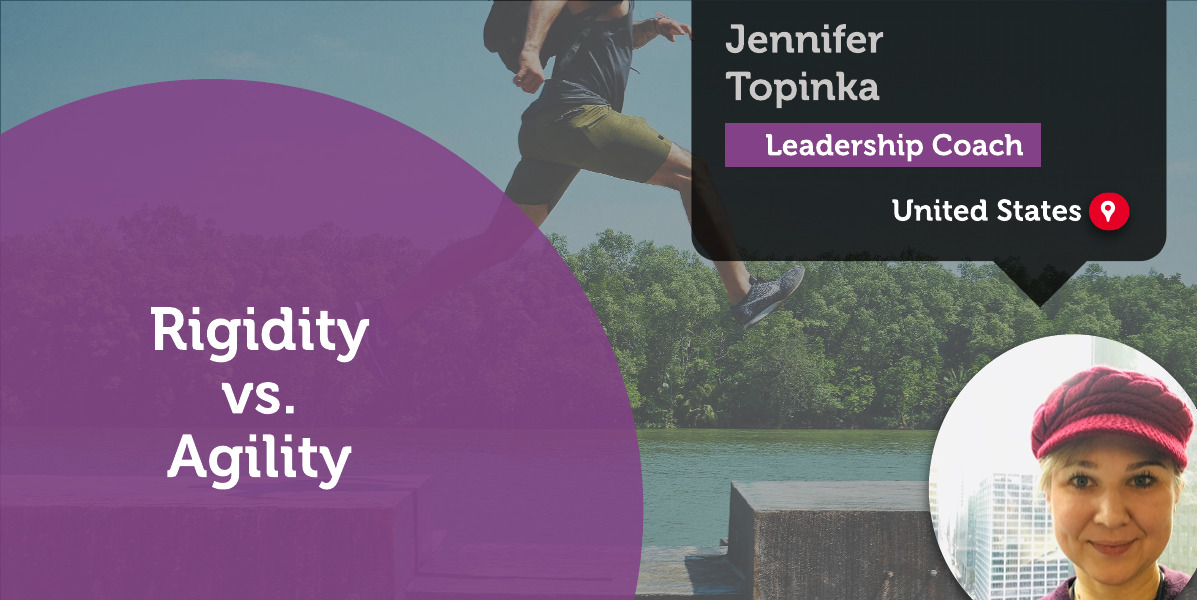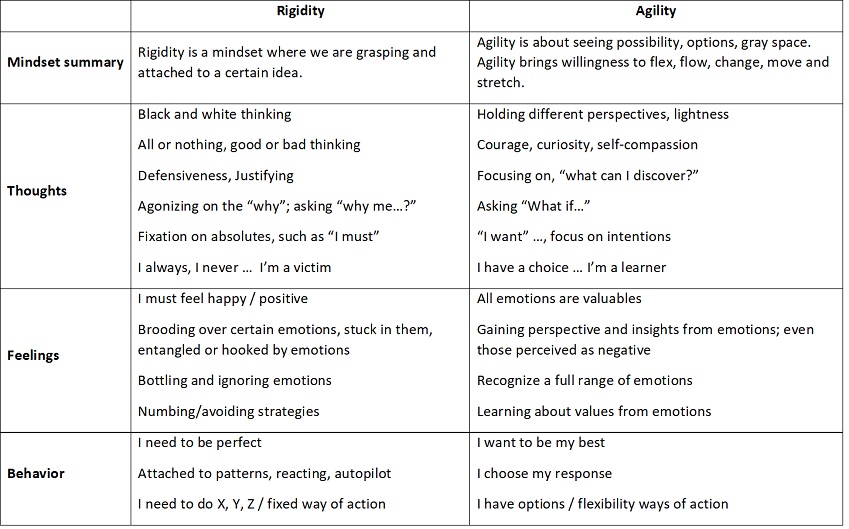A Coaching Power Tool By Jennifer Topinka, Internal Leadership Coach, UNITED STATES

Embracing Rigidity vs. Agility Mindset
…Nature has a funny way of breaking what does not bend. ~Jewel, Innocence Maintained
There is strength in agility and flexibility; we can’t be rigid and strong at the same time. To find strength and resilience, one must learn to develop agility.
Children and adults alike can be set in their ways. As the saying goes, “my way or the highway.” We can become “stuck”, at an impasse, because of a rigid mindset. In these situations, we rarely come out successful, it’s often a lose-lose situation if we cling to a rigid mindset.
When I’m rigid in my mindset, I feel disempowered, angry, hopeful, and frustrated. I spend my energy fighting, ruminating, and defending my position. The rigidity saps my energy and imagination. By purposefully shifting from a rigid to the agile mindset, I become more present, connect with reality, see possibilities, and move forward. An agile or flexible mindset is empowering.
Flexibility is strength … It’s true for the psyche as well as for the body. You’re strong when you’re supple and limber. So get up each morning and stretch. Develop the mental range of motion that keeps you free. ― Edith Eger, The Gift: 12 Lessons to Save your Life
Rigidity vs. Agility Explanation
Rigidity
Rigidity is a mindset where we are grasping and attached to a certain idea. Rigidity is the lack of seeing possibility, options, and gray space. When we are rigidly grasping expectations and beliefs, we are not free. The result of a rigid mindset brings self-imposed shackles. This rigid mindset holds us captive, a prisoner by our own doing. A rigid mindset can hold us in the pattern of succumbing to our automatic reactions instead of thoughtfully responding. Rigidity and reacting rob us of our ability to choose in the time between the stimulus and response.
In the book, Emotional Agility (David, 2016), Susan David describes emotional rigidity as either “bottling” or “brooding” our feelings and emotions. Brooding is continuously replaying and being entangled in emotion or feeling. Brooding is being owned by our emotions. Bottling is avoiding, numbing, and otherwise not acknowledging emotion or feeling. Bottling is when we push aside difficult emotions, preventing us from engaging with reality. Both brooding and bottling can be done with good intentions, but these tendencies keep us stuck.
Rigid Mindset:
- Black or white thinking; all or nothing mentality; being inflexible in expectations
- Lack of willingness to take a step back and see things from a different perspective
- The belief there is only one approach, desire to wait for the perfect opportunity
- Inflexible expectations and patterns need for perfectionism
- Not acknowledging all emotions and feelings
- Dwelling in the past (rumination)
- Being attached to staying in the comfort zone, resisting freedom; learned helplessness
… victimhood comes from the inside. No one can make you a victim but you. We develop a victim’s mind – a way of thinking and being that is rigid, blaming, pessimistic, stuck in the past, unforgiving, punitive, and without healthy limits or boundaries. We become our jailors when we choose the confines of the victim’s mind. Edith Eger, The Choice: Embrace the Possible.
Agility
Agility is about seeing a range of possibilities, holding multiple perspectives, and accepting “gray space”. An agile mindset is flexible, willing to change, and stretch. Agility brings a sense of fluidity, flowing, and adapt to the environment. Agility promotes questioning of assumptions and beliefs. It is about asking, “what if …?”, “is there another solution?”, and being curious and compassionate for self and others. With an agile mindset, all emotions are acknowledged from a healthy perspective, allowing the time and space for choice and learning.
Agility is about being present without resistance. In the book, Art of Possibility (Zander, 2002), the Seventh Practice is, “The way things are.” This practice is to see and be present to the way things are, including our feelings, without judgment. Embracing the “and” allows multiple perspectives, and positions us to ask, “what do we want to do from here?”. The capacity to be present to everything that is happening helps open pathways of possibility. (e.g., “We’re in Florida for our winter vacation AND it’s raining. This wasn’t what we planned; it’s very disappointing … AND this is the way things are. What do we want to do from here?”)
Agility is recognizing there are typically many possibilities, even many “means to an end.” When a situation or environment changes, this can call for a new strategy or plan, as highlighted in the book, Elastic Habits (Guise, 2019). Agility is demonstrated when significance is released and replaced with lightness, openness, and flexibility.
Just like our bodies are capable of being stretched and moved, our brains have evolved to be highly flexible, adaptive, and resilient. Neuroplasticity refers to the capability of our brains to adapt. Our brains are always changing based on our experiences (Eagleman, 2020). Given this, why not focus deliberate attention to embrace an agile mindset?
Agility embodies our realization that we have the power to choose our response. We are not tied to our automatic reaction but can use the space between the stimulus and our response to choose.
Agile Mindset:
- Seeing options, recognizing our choice to respond, freedom and opportunity
- Understanding that there probably isn’t just one right answer
- There are multiple ways to meet our objective
- Improvisation, adapting to the environment, and making the most of the current situation (EH)
- Willingness to leave the comfort zone, stretch, learn and grow
- Be honest with yourself. Be brave and curious to address vs avoid
- Embracing flexible expectations, adapting to the environment
Emotional agility is a process that enables us to navigate life’s twists and turns with self-acceptance, clear-sightedness, and an open mind. The process isn’t about ignoring difficult emotions and thoughts. It’s about holding those emotions and thoughts loosely, facing them courageously and compassionately, and then moving past them to ignite change in your life. ~Susan David, Author of Emotional Agility
Embracing “Emotional Agility”
Emotional agility is being aware of and accepting all emotions, even the most difficult ones. It involves getting beyond conditioned or preprogrammed cognitive and emotional responses. Emotional agility allows one to live in the moment with a clear awareness of present circumstances, respond appropriately, and then act in alignment with our deepest values. Susan David describes four stages for the application of Emotional Agility (David, 2016).
-
Showing Up
- Practice Self Compassion, Choose Willingness, Learn from Thoughts and Emotions
- Accept all these parts of our existence, without being crushed or terrified.
- Learn words for emotions and be aware of differences (e.g. guilt vs shame).
- Showing up takes courage: “Acceptance is a prerequisite for change.”
-
Stepping Out:
- Detach from thoughts and emotions and observe them for what they are with curiosity
- Create space between the stimulus and response
- Tools for use include: writing, seeing the meta-view / helicopter view, mindfulness, talking to self in the third person, naming your emotion “I feel” vs “I am”, recognizing you are not your emotion.
-
Walking your “why”
- Ask: What do I want my life to look like? What are my values?
- Consider your future self, take the long view; beware of the trap of social contagion
- Recognize the choice point is the “fork in the road” where you are presented with a choice. Each choice represents an opportunity to walk your why. Accept the pain associated with giving up the road not taken. You can embrace the decision you made and move forward with clarity.
-
Moving on
- Consider micro-moments which are small deliberate tweaks. Nature favors evolution, not revolution.
- Establish “want-to-goals” that are generated by a sense of true values (vs “have-to”)
- Practice the teeter-totter principle – Live at the end of your ability, choose courage over comfort, opt for what is workable.
How a Coach Can Contribute to Transforming Rigidity vs. Agility
In coaching, clients can arrive at a coaching session “stuck” because of a rigid mindset or perspective. Coaching questions and exploration areas:
Exploring “The Way Things Are”
- What is here now? What else is here now?
- What would it be like to be with the whole situation? (consider “and”)
- What assumptions or patterns are leading you to think/feel this way?
- For any “negative” feelings/emotions, what can they show about your values?
Listen for “shoulds” that may be holding a client in a rigid mindset; when attention is on how wrong things are, we lose the power to think about a solution and act effectively.
Look for strategies clients may use to avoid reality. In the HeART of Laser-Focused Coaching (Franklin, 2019), Marion Franklin describes strategies such as denial, obsession, displaced anger to avoid addressing what is happening in the present. By helping clients see these strategies and defenses, a coach can help the client uncover what is going on.
Exploring Options
- What do you want to do from here, after recognizing “the way things are”?
- What are other possible solutions? What else?
- What if …?
- What would it look like to approach this differently?
- If you were going to ask the kindest and wisest person in the world about this challenge, what would they say?
Rigidity vs. Agility Other Coaching Tools or Techniques
Reflective inquiry
In Coach the Person Not the Problem (Reynolds, 2020), Marcia Reynold stresses the importance of reflective inquiry as a key to coaching conversations. The process of reflective inquiry helps clients see their thoughts more objectively. When a coach uses reflective inquiry, clients can automatically see the gaps in their logic or what is no longer serving them such as blind spots to rigid thinking.
Elastic Habits
In Elastic Habits (Guise, 2019), Stephen Guise recognizes that “habits that bend don’t break.” Life is in motion, so why not build habits that are flexible and resilient? Elastic Habits outline examples of how to build habits that are fluid to survive the ebbs and flows of life.
- What is the difference between Emotional Intelligence and Emotional Agility?
- Consider your relationship with your feelings, are there situations where you notice brooding and bottling feelings?
- How do you “step out” to detach and observe emotions? For a technique, consider Pennebaker’s writing rules
- Where have you recognized rigidity in your mindset, and been able to shift to a mindset of agility?
References
David, S. Emotional Agility: Get Unstuck, Embrace Change, and Thrive in Work and Life. New York, New York: Penguin Random House.
Eagleman, D. Livewired: The Inside Story of the Ever-Changing Brain. Penguin Random House LLC.
Eger, E. The Choice: Embrace the Possible. New York, NY: Scribner.
Eger, E. The Gift: 12 Lessons to Save Your Life. New York, NY: Scribner.
Franklin, M. The HeART of Laser-Focused Coaching: A Revolutionary Approach to Masterful Coaching. Thomas Noble Books.
Guise, S. Elastic Habits: How to Create Smaller Habits That Adapt to Your Day. Selective Entertainment LLC.
Reynolds, M. Coach the Person Not the Problem: A Guide to Using Reflective Inquiry. Oakland, CA: Berrett-Koehler Publishers, Inc.
Zander, R. S. The Art of Possibility: Transforming Professional and Personal Life. Penguin Books.
The Power Tool of Rigidity vs. Agility
To experience a shift or change often requires being agile and flexible in how we are perceiving, interpreting, and responding to ourselves and the world. The Power Tool of Rigidity vs. Agility can be applied to our thoughts, feelings, and actions.
